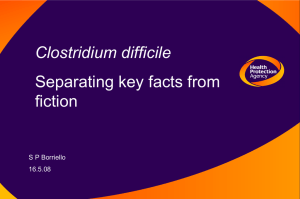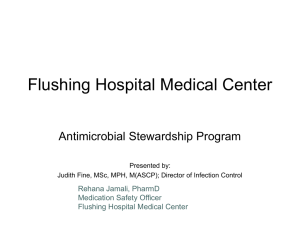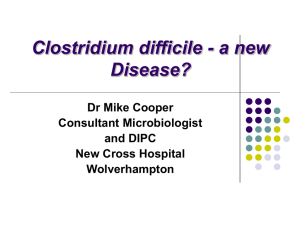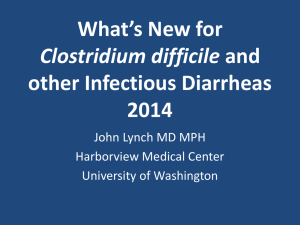Sample Final Draft of Research Proposal
advertisement
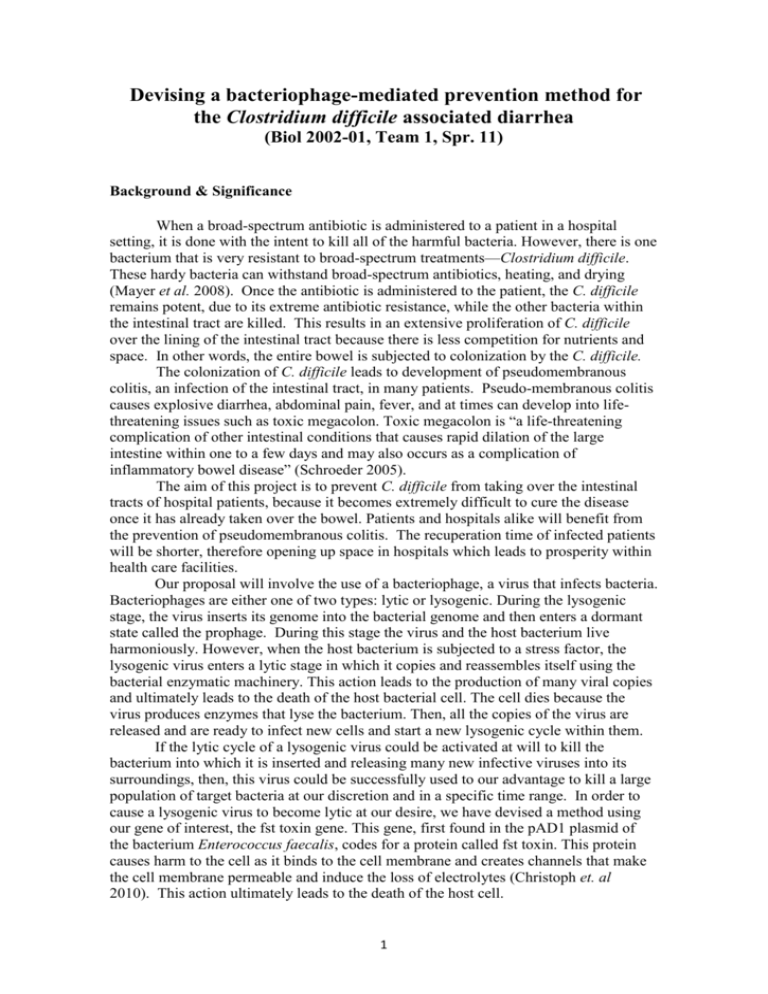
Devising a bacteriophage-mediated prevention method for
the Clostridium difficile associated diarrhea
(Biol 2002-01, Team 1, Spr. 11)
Background & Significance
When a broad-spectrum antibiotic is administered to a patient in a hospital
setting, it is done with the intent to kill all of the harmful bacteria. However, there is one
bacterium that is very resistant to broad-spectrum treatments—Clostridium difficile.
These hardy bacteria can withstand broad-spectrum antibiotics, heating, and drying
(Mayer et al. 2008). Once the antibiotic is administered to the patient, the C. difficile
remains potent, due to its extreme antibiotic resistance, while the other bacteria within
the intestinal tract are killed. This results in an extensive proliferation of C. difficile
over the lining of the intestinal tract because there is less competition for nutrients and
space. In other words, the entire bowel is subjected to colonization by the C. difficile.
The colonization of C. difficile leads to development of pseudomembranous
colitis, an infection of the intestinal tract, in many patients. Pseudo-membranous colitis
causes explosive diarrhea, abdominal pain, fever, and at times can develop into lifethreatening issues such as toxic megacolon. Toxic megacolon is “a life-threatening
complication of other intestinal conditions that causes rapid dilation of the large
intestine within one to a few days and may also occurs as a complication of
inflammatory bowel disease” (Schroeder 2005).
The aim of this project is to prevent C. difficile from taking over the intestinal
tracts of hospital patients, because it becomes extremely difficult to cure the disease
once it has already taken over the bowel. Patients and hospitals alike will benefit from
the prevention of pseudomembranous colitis. The recuperation time of infected patients
will be shorter, therefore opening up space in hospitals which leads to prosperity within
health care facilities.
Our proposal will involve the use of a bacteriophage, a virus that infects bacteria.
Bacteriophages are either one of two types: lytic or lysogenic. During the lysogenic
stage, the virus inserts its genome into the bacterial genome and then enters a dormant
state called the prophage. During this stage the virus and the host bacterium live
harmoniously. However, when the host bacterium is subjected to a stress factor, the
lysogenic virus enters a lytic stage in which it copies and reassembles itself using the
bacterial enzymatic machinery. This action leads to the production of many viral copies
and ultimately leads to the death of the host bacterial cell. The cell dies because the
virus produces enzymes that lyse the bacterium. Then, all the copies of the virus are
released and are ready to infect new cells and start a new lysogenic cycle within them.
If the lytic cycle of a lysogenic virus could be activated at will to kill the
bacterium into which it is inserted and releasing many new infective viruses into its
surroundings, then, this virus could be successfully used to our advantage to kill a large
population of target bacteria at our discretion and in a specific time range. In order to
cause a lysogenic virus to become lytic at our desire, we have devised a method using
our gene of interest, the fst toxin gene. This gene, first found in the pAD1 plasmid of
the bacterium Enterococcus faecalis, codes for a protein called fst toxin. This protein
causes harm to the cell as it binds to the cell membrane and creates channels that make
the cell membrane permeable and induce the loss of electrolytes (Christoph et. al
2010). This action ultimately leads to the death of the host cell.
1
The expression of the fst toxin gene can become a stress factor within a
bacterium carrying a prophage and thus, it could most likely induce the lytic stage of
this virus, which will ultimately kill the cell. This could be achieved by attaching a
promoter of a gene whose expression we can control next to the fst toxin gene so that
we can induce its expression.
Similar mechanisms work by inserting the lac promoter from the lac operon next
to a gene of interest and then introducing this construct into an E. coli. The expression
of the gene can be mediated by adding lactose to the growth media the E. coli is
growing in as this sugar induces the expression of the lac operon. This prompts the lac
promoter to initiate the transcription of the gene next to it, which in this case is the gene
of interest. However, no evidence indicating the possession of the lac operon by C.
difficile was found, therefore, another promoter from an operon used by C. difficile was
needed. The xylose operon, which is the analogue of the lactose promoter but for the
sugar known as xylose, was found suitable to be used, as it is present in the Clostridium
genera.
We could join the xylose promoter next to the fst toxin gene and take that gene
sequence and introduce it to C. difficile. Then, we could expose these bacteria to xylose
so that the fst toxin gene expression is triggered. This expression of the fst toxin gene
will harm the bacteria and act as a stressor that ultimately will kill them. Therefore, this
combination of the xylose promoter and the fst toxin gene could be considered a suicide
construct. Furthermore, if this construct was inserted into the genome of a lysogenic
bacteriophage specific for C. difficile, we would have a way to deliver this construct
into the bacterial DNA and control its expression. The stress caused by the toxin will
trigger the lytic stage of the lysogenic virus and thus the cell will be killed.
Since we can trigger the cell death at our own desire, this method can
successfully be used to prevent the infection and disease by C. difficile on patients
undergoing a broad-spectrum antibiotic therapy. This virus could be administered
together with the intake of the antibiotics, infecting any C. difficile they come in contact
with inside the intestinal tract. These cells will be killed by the virus after the prophage
stage is induced by the deliberate intake of xylose.
Many methods could be employed to deliver this suicide construct-carrying
virus to the intestinal tract. We propose the use of a non-virulent strain of C. difficile
which could be inserted into the intestinal tract in many ways, even inside a pill. This
C. difficile will already be carrying the prophage of our suicide construct-carrying virus.
Then, by administering xylose, the death of this cell and the release of many infective
viruses will be triggered. Such viruses will be ready to infect any wild type C. difficile
found within the intestinal tract and will lyse the bacteria after repeated administrations
of xylose following the same mechanism.
This prevention treatment has many advantages as the use of a few non-virulent
cells of C. difficile infected with the prophage of the aforementioned virus could
generate many infective copies of such virus. These viruses can, in turn, kill many wild
type C. difficile present in the intestinal tract through the mechanism mediated by the
addition of only one cheap, non-absorbable and non-toxic reagent: xylose.
Many other genes were considered besides the fst toxin gene. We initially
considered using the hok gene, which causes similar effects in bacteria but only occurs
in gram negative bacterium. Since the fst toxin gene is present on a gram positive
bacterium, Enterococcus faecalis, its use is plausible, as C. difficile is also a gram
positive. Furthermore, the lambda phage, which infects E. coli, was firstly considered to
be the bacteriophage that would carry the suicide construct. However, no evidence was
2
found to conclude that the lambda phage would infect C. difficile, so we chose to use
the bacteriophage phi CD119 due to its recent DNA sequencing.
Research Plan
The long-term goal of this research is to devise a prevention method for the
infection by Clostridium difficile (and subsequent Clostridium difficile-associated
diarrhea, CDAD) in patients undergoing a broad spectrum antibiotic therapy. Our work
will center on modifying a lysogenic virus specific for C. difficile by inserting a
construct made by joining the xylose promoter of the xylose operon and the fst toxin
gene. We hypothesize that if the prophage of this modified virus is already inside C.
difficile when such cell is exposed to xylose, the expression of the fst toxin gene will be
triggered by this exposure. The fst toxin produced by such exposure to xylose will
become a stress factor in the bacterium that will cause the former prophage to enter its
lytic cycle, killing the C. difficile as a result. This process will release many infective
viruses carrying the aforementioned construct that will attack other C. difficile and lyse
them in the presence of xylose. As implied by this procedure, by introducing the
aforementioned construct within the genome of this lysogenic bacteriophage, a way of
triggering the lytic cycle of this virus at our discretion will be obtained. This could be
advantageous as we could safely deliver the prophage of this virus into the intestinal
tract inside non-virulent C. difficile and then, trigger the lytic cycle of such virus by
exposing the bacteria to xylose. The virus will then replicate, lyse the bacteria and be
released into the intestinal tract, ready to infect other C. difficile. Any virulent C.
difficle present in the gut at that time will be infected by the virus and due to the
exposition of these bacteria to xylose; the lytic cycle of the virus will be triggered,
killing these C.dificile. This process gives us a way to prevent or counter the infection
of C. difficile inside the intestinal tract without using antibiotics.
A well-known lysogenic virus specific for C. difficile is needed to carry out this
proposal. Because the bacteriophage phi CD 119 has already been sequenced and
analyzed by Govind et al. (2006) and such information about its genome sequence is
available, we will use this virus to bring about our proposal. A restriction site to insert
the xylose promoter – fst toxin gene construct that does not disrupt the viral ability to
replicate, reassemble and lyse its host has to be found. After analyzing the phi CD119
viral genome with the software NEBcutter (Vincze et al. 2003), a unique restriction site
for BlpI was found that was within a non-coding region of this genome. Therefore, this
restriction site was selected to be the one in which the construct will be inserted as this
insertion would not disrupt the viral ability to replicate and assemble itself.
Our general hypothesis has been broken-up into the particular postulates stated
below that need to be proved in order for our proposal to be successful:
1) The expression of the fst toxin gene can be induced when attached to the xylose
promoter in the presence of xylose when this whole construct is inserted into the
genome of C. difficile.
2) The fst toxin will effectively act as a stress factor that will trigger the lytic cycle of the
lysogenic bacteriophage phi CD119 if this virus is already a prophage within the
bacterial genome of C. difficile.
3) A construct containing the xylose promoter sequence and the fst toxin gene sequence
can be assembled and inserted into the phage phi CD119 at a specific site without
disrupting its replication and assembly.
3
4)
If the phi CD119 xylose promoter - fst toxin gene construct-carrying virus is already a
prophage within the genome of C. difficile, the lytic cycle of such virus can be triggered
by having the bacterium use xylose as its sole carbon source.
5) The infection of multiple C. difficile cells and its subsequent lysis can be attained by
mixing such cells with a group of C. difficile cells carrying the prophage of the virus
mentioned in #4 and making these cells use xylose as the their only carbon source both
in a culture and within a hamster disease model.
The achievement of the following specific aims will be necessary to prove all of
our particular postulates stated above:
Specific aim # 1:
Design a construct by joining the xylose promoter (xylA) sequence and the fst
toxin gene sequence. This construct must have restriction sites on its ends that will
allow it to be later introduced into the genome of the lysogenic virus phi CD119.
Methods for specific aim # 1
Two plasmids, one carrying the fst toxin gene and another carrying the
xylose promoter sequence have to be obtained. The plasmid pDAK606 (shown
in figure 2), that contains the fst toxin gene sequence, will be obtained from
Weaver et. al, and used as a template to isolate and amplify such gene using the
polymerase chain reaction (PCR). The plasmid pXYLgusA (shown in figure 3),
that contains the xylose promoter sequence (xylA), will be obtained from Girbal
et al. and used as a template to isolate and amplify by PCR the sequence of the
such promoter. The primer sequences that will flank these two genes will be
designed so that the xylA amplified product and the fst gene amplified product
have an EcoRI site at the 3’ and 5’ end respectively. In addition, these primers
will be designed so that the aforementioned amplified products have a BlpI site
at the 5’ end of the xylA sequence and at the 3’ end of the fst gene. Both genes
will be joined together with DNA ligase to assemble the construct.
Specific aim #2:
Insert the aforementioned construct inside the viral genome of the phage phi
CD119 without disrupting the ability of the virus to replicate, reassemble and lyse its
host. Infect a culture of C. difficile with this modified virus and induce the lysis of the
bacteria by growing them in a xylose media. Provided that the construct worked and
was successfully inserted into the genome of the phage phi CD119 without disrupting it,
collect such virus from the plaques formed. A schematic drawing of the modified phage
phi CD119 is shown in figure 1.
Methods for specific aim # 2:
The prophage of the phage phi CD119 within its host C. difficile strain
602 will be obtained from Govind et al. These bacteria will be grown in Brain
Heart Infusion (BHI) agar and the lytic cycle of the virus will be induced with
the antibiotic mytomicin C, following the procedures used by Govind et al in
2006. The virus will be collected from the plaques. The viral genome will be
isolated and separated from the viral proteins and then digested with BlpI. The
digested viral genome will be combined with the construct and both, the viral
genome and the construct, will be joined with DNA ligase.
The solution containing the modified viral genome will be combined
with cells of C. difficile strain 602 and its entry to the bacterial cell will be
mediated by electroporation. Every functional viral genome should be capable of
4
integrating into the bacterial chromosome on its own as it comes from a
lysogenic virus. The bacteria will be grown in BHI agar for many generations
and then transferred to a xylose containing media. Viruses containing the
construct should be collected from the plaques formed. PCR will be performed
targeting the construct sequence on the viruses collected to verify the successful
insertion of such construct into the viral genome. The modified viruses carrying
the construct will be harvested by repeating the aforementioned procedure.
Specific aim # 3:
Create a non-virulent C. difficile culture an expose it to the modified phage phi
CD119. Insert these non-virulent bacteria into the intestinal tract of a hamster that has
had its intestinal flora removed. Challenge this hamster with a virulent strain of C.
difficile and administer xylose to the intestinal tract of the hamster. Observe if the
virulent C. difficile population decreases over time due to the infection and lysis by the
modified virus. After the non-virulent C. difficile carrying the prophage of the modified
virus phi CD119 are exposed to xylose, they should be lysed by this virus and release
many copies of it into the intestinal lumen. This virus should then infect the virulent C.
difficile and due to the continuous exposition of these cells to xylose, they should also
be lysed by the virus.
Methods for specific aim # 3:
Produce a non-virulent culture of C. difficile strain 602, by following the
methods explained by Kuehne et al. (2010), that is, by using the ClosTron gene
knockout system to insert bacterial group II introns within the tcdA and tcdB
genes of C. difficile to knock them out. Expose this strain to the modified phage
phi CD119 so that this virus can integrate into to the bacterial genome of this
mutant C. difficile. Follow the procedure used by Vijayashree Ramesh (1998) to
create a hamster disease model in which we will be able to perform the
experiment described in our particular postulate #5; that is, setting up a sterile
environment for the hamster to live: sterile cage, food, water and bedding. Select
a group of these hamsters and remove their intestinal flora from their intestinal
tracts with 1ml of clyndamicin (3g/100mg of body weight) intragastrically, that
is, by using a line inserted into the hamsters’ stomach, as described by V.
Ramesh (1998). Inoculate the intestinal tract of these hamsters with the nonvirulent C. difficile strain 602 carrying the modified phi CD119 at different
concentrations. Collect the stools of these hamsters and dilute them in 1 ml of
saline solution. Analyze these stool samples with real-time polymerase chain
reaction (qPCR) targeting the viral genome to determine the correct
concentration of administered bacteria at which the colonization the hamsters’
intestinal tract is successful. Once the right concentration is found, administer
xylose at different concentrations to these hamsters, collect their stools after
each inoculation and do a qPCR to these stools targeting the viral genome to
find the concentration of xylose that induces the lysis of the bacteria and the
viral release.
Repopulate the intestinal tract of the hamsters with the non-virulent C.
difficile, challenge these hamsters with virulent C. difficile strain 602 and
continuously administer xylose to them intragastrically. Quantify the
concentration of the virulent strain of C. difficile against that of the non-virulent
strain of C. difficile over time in the hamsters’ stools to evaluate if, after the
addition of xylose, the concentration of virulent C. difficile in the hamster’s
5
intestinal tract decreases as expected. At the same time, evaluate the challenged
hamster for signs corresponding to the C. difficile associated diarrhea. A flow
chart of the research plan is shown in figure 5.
Discussion
Because of its financial and life costs, pseudomembranous colitis caused by C.
difficile has been researched extensively. The results of past research projects have
given us the confidence that our project proposal will succeed. Though we are positive
in our outlook there are several possible issues that we must first address.
The vector we choose must successfully lyse C. difficile in an environment (the
human intestinal lumen) that has already been subjected to broad spectrum antibiotics.
The fst toxin gene is part of a toxin- antitoxin system that is known to be capable of
lysing gram-positive bacteria (Christoph et. al 2010). As C. difficile is a gram-positive
bacterium, we can safely assume that the fst toxin gene expression will cause harm to C.
difficile.
We need a procedure that will introduce the bacteriophage to the digestive
system without harming the patient or destroying the function of the bacteriophage.
Research has been done using Salmonella carrying RNase P ribozyme into the body of a
mouse in order to kill Cytomegalovirus. They were able to successfully deliver the
RNase P ribozyme into the body using Salmonella that was administered via oral
inoculation. Once in the body, enzymes within the bacteria were released into the
human macrophage, removing the temperate virus from the genome (Bai et. al 2011).
We will imitate this procedure and administer non-virulent C. difficile (carrying the
prophage of the virus with the suicidal construct) orally. We can be confident that the
bacteria will then arrive safely into the intestine without harming the patient.
Once the phage is introduced into the body, we need to induce it so that it enters
the lytic cycle and lyses the C. difficile cells. The use of xylose ensures that the lytic
cycle will be induced by activating the promoter that controls expression of the fst toxin
gene. This will increase the amount of fst toxin, which will then stress the cell (Kok.
1996; Hu et al 2010). Through this stress, the phage will enter its lytic cycle and kill
C.difficile.
One problem that arises when working with temperate phages is transduction.
Normally the prophage is cut from the bacterial genome and is inserted into its already
assembled capsid where it becomes infective and can attack another cell (Novick 2010).
However, it is possible for a mistake to happen in this process, leading to a portion of
bacterial DNA to be cut off from the bacterial genome and inserted inside a viral capsid.
The capsid is still infective and transfers this piece of DNA which may carry a
beneficial gene into another bacterium when it tries to infect it. This could be
detrimental because if this piece of DNA codes for a virulence factor, that factor can be
transferred among bacteria making them more virulent or antibiotic resistant. If this
were to happen, the transduction process would generate many strains of bacteria that
will carry antibiotic resistant or virulence-factor coding genes.
Another problem when working with bacteria is the phenomenon of
transformation. In this case, with the elimination of many bacteria, the DNA of these
bacteria is released into the surrounding area and other bacteria can pick up these DNA
fragments and incorporate them into their genomes (Ochman. 2000). If again, these
genes code for antibiotic resistance or virulence, this could create harmful bacteria that
will be more of a problem than a solution.
6
Using the Basic Local Alignment Search Tool, BLAST, primary biological
sequences such as amino acids can be compared to a database of known sequences. A
search was performed with the fst toxin and Enterococcus faecalis. Only one other
organism besides E. faecalis was found with a similar protein. As seen in figure 4,
these two bacteria species are closely related to one another. The ortholog found in
Lactobacillus gasseri was found to code for a hypothetical protein similar to the product
of the fst toxin gene found in E. faecalis with a score of 42% and 14/33 identities
matching. L. gasseri is an anaerobic, gram-positive bacterium found in the
gastrointestinal tract of animals and humans. While this score appears low, the
hypothetical protein coding sequence is 35 base pairs long, and it is possible that this
sequence could match another portion of the genome. Because this is such a small
segment and because L. gasseri resides in the gut, gene transfer between the two
organisms is possible. L. gasseri is a probiotic commonly found in yogurt. While these
bacteria are beneficial to the organism, if such a gene transfer occurs, there is a chance
that the bacteria will be destroyed and the lactose cannot be broken down. Such an event
could lead to lactose intolerance in the patient to whom the treatment is being
administered, and could greatly affect such patient’s diet. This possible outcome would
have to be investigated and further research attention must focus on L. gasseri.
Since there are multiple strains of disease-causing C. difficile and each is
infected by a narrow array of bacteriophages, this treatment will have to be repeated
using many viruses (instead of phiCD119) that are lysogenic and specific to C. difficile
and several strains of non-virulent C. difficile to carry them. Since we will be testing our
genetically modified organism in a hamster, there is the possibility that it will react
differently in the human body or not work at all. If the treatment is viable in humans we
would have to do further research on how often patients would need to take the
treatment to make it effective.
A risk for the patients involved in this experiment is the rate at which the C.
difficile is killed. If it is lysed too quickly, toxins contained inside the bacteria will be
released into the intestinal tract, causing a harmful build-up of toxins in the intestinal
tract. Such a problem would amplify the symptoms the patient exhibits from the original
infection. Killing all of the bacteria at once could be disastrous and cause numerous
complications for the patients. This issue could be addressed by combining the
treatment with “developing therapies that aim to neutralize the toxins, including the use
of antibodies and toxin-absorbing agents such as Tolevamer.” (Mayer et. al 2008)
However, if the C. difficile is not killed quickly enough, there will be time for the C.
difficile to repopulate the gut, making it very difficult to cure the patient. Nevertheless,
if the treatment is administered early as a preventative measure, no infection should
arise, leaving the patient unharmed.
If our project does not work as a prevention method, we could clone and harvest
the products of the genes that code for the proteins holin and endolysin. These are
enzymes that permeabilize the bacterial cell wall and cause cell lysis. These genes will
be isolated from a virus lytic to C. difficile and cloned inside E. coli, following the
procedure described by Mayer et. al (2008). We will isolate the holin/endolysin genes
from the viral genome and insert them into a plasmid. This plasmid would then be
inserted into E. coli and the expression of the genes of interest will be induced. This
expression will lead to the harvest of products of these genes. These products will then
be isolated and collected and turned it into a pill to be used as a preventive treatment
method. When a patient takes the pill, the endolysin and holin proteins would be
released inside the intestinal tract. If there were C. difficile in the patient’s digestive
7
tract, the holins and endolysins would bind to the bacterial cell walls, permeabilizing
them and causing the cell death.
Since we are using living organisms, hamsters, we will need to ensure the wellbeing of these animals. We will monitor the health of the hamsters as a result of our
experiment both before and after the procedure. If the experiment were successful, and
the hamsters were able to survive after being subjected to C. difficile, they will be
exposed again to the pathogen some time later in absence of the treatment to confirm
that it was the treatment what saved them. Had the treatment been successful, these
hamsters would most likely die due to a second infection of C. difficile. Although this
raises ethical questions, the benefit from these studies is worth the death of the test
subjects; many lives and dollars can be saved if we can find a prevention method for the
CDAD.
Assuming this project is successful, the next step would be to start testing of this
procedure on humans. Future studies should investigate the management of potential
treatment complications, such as the buildup of harmful toxins or recolonization of C.
difficile. Additionally, if this project can prevent the infection of one species of harmful
bacteria, more work could be done to decide if this method could be used on other
bacterial infections. Perhaps we could use this method to effectively kill other harmful
bacteria species in the intestine (or elsewhere in the body) in a safe and cost-effective
way.
References
Bai Y, Gong H, Li H, Vu GP, Lu S, Liu, F. 2011. Oral delivery of RNase P ribozymes
by salmonella inhibits viral infection in mice. Proceedings of the National
Academy of Sciences 108(8): 3222-3227.
Barksdale L, Arden SB. 1974. Persisting bacteriophage infections, lysogeny, and phage
conversions. Annu Rev Microbiol 28(1):265-300.
Christoph G, Kosol S,Stockner T, Rckert H, Zangger K. 2010. Solution structure and
membrane binding of the toxin fst of the par addiction module.
Biochemistry 49(31): 6567-6575.
Dürre P (Ed.). 2005. Handbook on clostridia. Boca Raton, Florida: CRC Press Taylor
& Francis Group.
Girbal L, Mortier-Barriere I, Raynaud F, Rouanet C, Croux C, Soucaille
P. 2003. Development of a sensitive gene expression reporter system and an
inducible promoter-repressor system for clostridium acetobutylicum. Appl.
Environ. Microbiol. 69: 4985-4988.
Govind R, Fralick J, Rolfe R. 2006. Genomic organization and molecular
characterization of clostridium difficile bacteriophage {phi}CD119. The Journal
of Bacteriology 188(7): 2568-2577.
Greenfield T, Franch T, Gerdes K, Weaver K. 2001. Antisense RNA regulation of the
par post-segregational killing system: Structural analysis and mechanism of
binding of the antisense RNA, RNAII and its target, RNAI. Molecular
Microbiology 42(2): 527-537.
Heap JT, Kuehne SA, Ehsaan M, Cartman ST, Cooksley CM, Scott JC, et
al. 2010. The ClosTron: Mutagenesis in clostridium refined and streamlined.
Journal of Microbiological Methods 80(1): 49-55.
Hu M, Zhang X, Li E, Feng Y. 2010. Recent Advancements in Toxin and Antitoxin
Systems Involved in Bacterial Programmed Cell Death. International Journal of
Microbiology. 781430.
8
Kuehne SA., Cartman ST, Heap JT, Kelly ML, Cockayne A, Minton NP. (2010).
The role of toxin A and toxin B in clostridium difficile infection. Nature
467: 711-713.
Kok J 1996. Inducible gene expression and environmentally regulated genes in lactic
acid bacteria. Antonie Van Leeuwenhoek 70: 129-14.
Mayer M, Narbad A,Gasson M. 2008. Molecular characterization of a clostridium
difficile bacteriophage and its cloned biologically active endolysin. The Journal of
Bacteriology 190(20): 6734-6740.
Novick R, Christie G, Penadés J 2010. The phage-related chromosomal islands of
Gram-positive bacteria. Nature Reviews Microbiology 8: 541-551
Ochman H, Lawrence J, Groisman E 2000. Lateral gene transfer and the nature of
bacterial innovation. Nature. 405: 299-304.
Ramesh V. 1998. Bacteriophage therapy of clostridium difficile induced intestinal
disease in a hamster model. Graduate Faculty of Texas Tech University Health
Sciences Center.
Schroeder MS. 2005. Clostridium difficile—associated diarrhea. PubMed Health. Am
Fam Physician. 2005 Mar 1;71(5): 921-928.
Vincze, T., Posfai, J. and Roberts, R.J. NEBcutter: a program to cleave DNA with
restriction enzymes. Nucleic Acids Res. 31: 3688-3691 (2003)
Weaver KE, Ehli EA., Nelson JS, Patel S. 2004. Antisense RNA regulation by stable
complex formation in the enterococcus faecalis plasmid pAD1 par addiction
system. Journal of Bacteriology 186: 6400-6408.
9
Figures
Figure 1. Modified phi CD119 virus carrying the xylA promoter – fst toxin gene construct. As seen from
figure 1, the xylA promoter sequence (1166 bp) and the fst toxin gene (400bp) have been joined together
using an EcoRI site. BlpI sites were inserted by PCR to both ends of the suicide construct so that it could
be inserted within one of the many BlpI sites present in the viral genome.
10
Figure 2. Schematic drawing of the plasmid pDAK606. This plasmid is going to serve as a template to
obtain the fst toxin gene. It has spectinomycin resistance gene as a selectable marker.
Figure 3. Schematic drawing of the plasmid pXYLgusA. This plasmid is going to serve as a template to
obtain the xylose promoter-operator sequence (xylA). It has two selectable markers, one for ampicillin
and another for erythromycin
11
Figure 4. Phylogenetic tree of various bacteria species found in the intestinal tract. This shows the
genomic relationship between these species and serves as an divergent evolutionary map.
12
Figure 5. Flow chart of the research plan.
13

